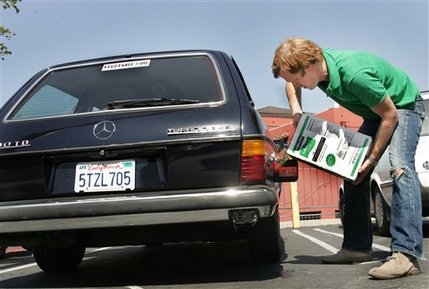
Straight Vegetable Oil (SVO) fuel systems are diesel motors modified to use vegetable oil instead of petroleum diesel for fuel. The lower viscosity of SVO requires a heated fuel tank, an in-line fuel heater and specialized parts to make the oil thin enough to burn in a compression engine. The average diesel vehicle owner can modify a vehicle to use SVO in about four hours.
Install an in-line fuel heater to the fuel line of the diesel motor by disconnecting the line near the intake manifold, then attaching a fuel heater to it with line bolts. Kits are available that include this heater, which basically surrounds the steel line with an electrically charged heating element. Most heaters are 12-volt units that must be connected to the vehicle's battery; they are high-draw devices that require a fully charged or running vehicle to operate.
Install a heated fuel tank, or modify the existing secondary tank by wrapping it in a powered heater element. Because SVO has a lower viscosity than petrol diesel fuel, the oil can solidify as it cools. Heating the tank will liquefy the fuel and make it thin enough to run through the lines to the engine.
Twin tank systems are operated with a manual or automatic switch to alternate between the first tank (diesel) and the second, heated tank (SVO). Fuel line switching solenoids are available in SVO kits, or can be fabricated from automotive parts (using a solenoid from a twin-tank vehicle, for example).
Start and run the vehicle up to operating temperature while on petrol diesel fuel, then switch over to SVO when it is warmed up. This prevents "coking," or cooler particles of vegetable oil from collecting on the valves and fuel intake components, by flushing them out with the detergents present in petrol fuel. This process will be reversed when the engine is shut down; the vehicle should be allowed to run on diesel for about 2 or 3 minutes before actually turning the motor off.
Install an optional temperature gauge to monitor the heat of the tank and lines, and place the gauge in an accessible area of the dashboard. This is recommended if using a twin-tank system, to know when to switch over to the SVO and back again. An optimal temperature range is between 140 and 160 degrees F; temperatures above 190 degrees F can cause damage to unprotected engine components.
Filter the SVO through a 3-micron heat-resistant filter, available in kits or where common food cooking equipment is sold. SVO must be filtered, preferably while warm, to remove solid particles that will clog or damage the vehicle's fuel system.